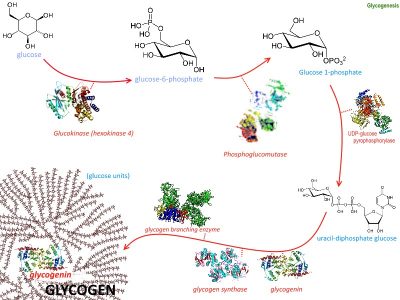Glycogenesis Definition
Glycogenesis is the biological process of forming glycogen from glucose, the simplest cellular sugar. The body creates glycogen through the process of glycogenesis to store these molecules for use later, when the body does not have readily available glucose. Glycogen is not the same as fat, which is stored for long term energy. Glycogen stores are often resorted to between meals, when the blood glucose concentration has dropped. In this case, the cells of the body resort to their stores of glycogen, undergoing the reverse process from glycogenesis. This process is called glycogenolysis.
Glycogenesis Process
To start the process, the cell must have an excess of glucose. Glucose is the starting molecule, and is modified through the process of glycogenesis. Through the modifications, it gains the ability to be stored in long chains. The process starts when the cell receives a signal from the body to enter glycogenesis. These signals could come from a number of different routes, and are discussed in a later section. When glucose enters the glycogenesis process, it must be acted on by a number of enzymes as seen in the image below.
First, the glucose molecule interacts with the enzyme glucokinase, which adds a phosphate group to the glucose. In the next step of glycogenesis, the phosphate group is transferred to the other side of the molecule, using the enzyme phosphoglucomutase. A third enzyme, UDP-glucose pyrophosphorylase, takes this molecule and creates uracil-diphosphate glucose. This form of glucose has two phosphate groups, as well as the nucleic acid uracil. These additions aid in the next step, creating a chain of molecules.
A special enzyme, glycogenin, takes the lead in this part of glycogenesis. The UDP-diphosphate glucose can form short chains by binding to this molecule. After around 8 of these molecules chain together, more enzymes come in to finish the process. Glycogen synthase adds to the chain, while glycogen branching enzyme helps create branches in the chains. This leads to a more compact macromolecule, and thus more efficient storage of energy.
Function of Glycogenesis
Glycogenesis is used to create glycogen from glucose, storing the energy within the bonds for future use. Glucose itself cannot be stored for a number of reasons. First and foremost, the enzymes within cells are prone to actively using glucose as quickly as possible. To save energy for times of no food intake, organisms must have a back-up source. When the cells have depleted all their glucose and are not receiving more from the body, they can turn to their stores of glycogen. Muscle cells, for example, commonly use glycogenesis to provide energy while exercising, because the blood glucose concentrations are not sufficient. The idea of “carbo-loading” (eating carbs and sugar before and athletic event) is based on the idea that cells will undergo glycogenesis and store as much glycogen as possible. Thus, when they need the energy during the exercise, it is readily available from glycogenolysis.
A second function of glycogenesis is that of water conservation and management. A glucose molecule is a polar sugar molecule which is not tightly packed. The process of glycogenesis produces molecules which are less polar and much more compact than glucose. This means that a cell can store many glucose molecules in a single glycogen molecule, and upset the water balance less. Every salt and sugar within the cytoplasm takes a certain amount of water to surround and suspend. If cells stored only glucose for later, they would soon need more water than the volume of the cells could hold, and would burst. Glycogen reduces this, but also takes water to store.
Regulation of Glycogenesis
Epinephrine
Epinephrine, also called adrenaline, is the hormone released in the fight-or-flight response. In other words, it is the chemical released when your body is frightened or stressed. Epinephrine negatively regulates glycogenesis, by disrupting the proteins necessary for the process. During a flight-or-fight response, the body wants all the available energy ready for disposal by the cells. Thus, it stops glycogenesis, starts glycogenolysis, and starts converting the glucose into energy. The cells will need much ATP to overcome the threat presented.
Insulin
When the body receives a large meal and the blood glucose levels are up, the pancreas releases insulin, a hormone which tells the cells to uptake and store glucose. This stimulates the process of glycogenesis, causing the cells to store glycogen and reduce the sugar present in the blood. Lots of glycogen is stored in the liver, which can then release it as glucose back into the blood stream between meals to keep the blood glucose at tolerable levels.
Quiz
References
- Feldhamer, G. A., Drickamer, L. C., Vessey, S. H., Merritt, J. F., & Krajewski, C. (2007). Mammology: Adaptation, Diversity, Ecology (3rd ed.). Baltimore: The Johns Hopkins University Press.
- Lodish, H., Berk, A., Kaiser, C. A., Krieger, M., Scott, M. P., Bretscher, A., . . . Matsudaira, P. (2008). Molecular Cell Biology (6th ed.). New York: W.H. Freeman and Company.
- Nelson, D. L., & Cox, M. M. (2008). Principles of Biochemistry. New York: W.H. Freeman and Company.

